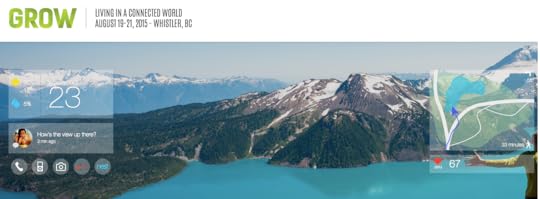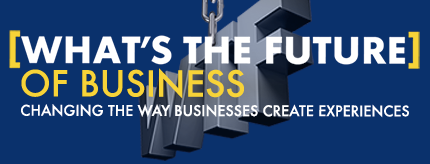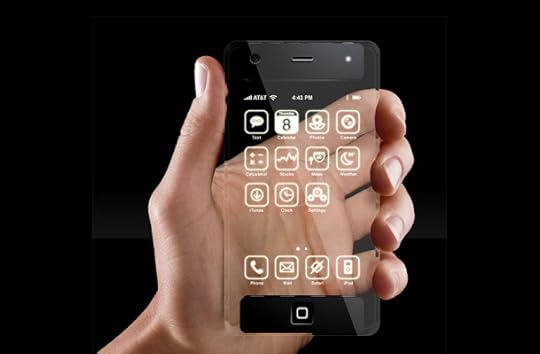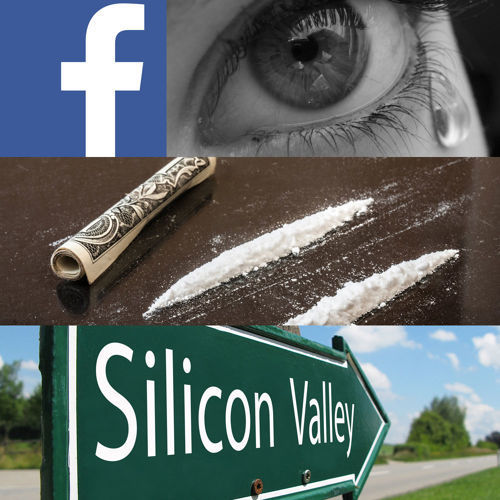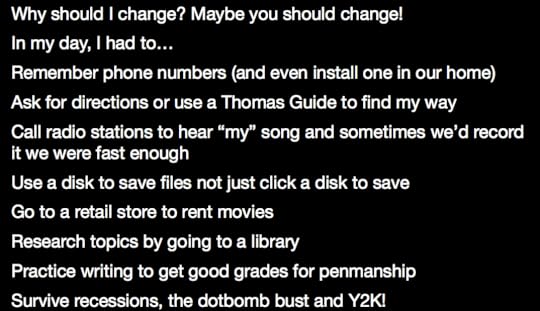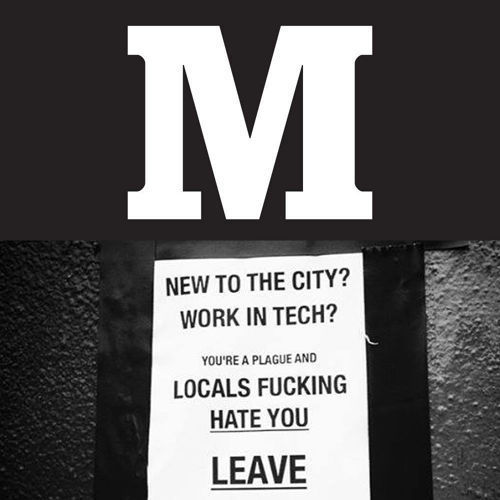Brian Solis's Blog, page 104
March 12, 2015
I’m Pivoting Toward Growth
Even Pivots make pivots. Such is true for the Pivot Conference. After 5 wonderful years, Pivot is moving away from a traditional conference format toward one focused on “user generated learning experience.” I’m moving into an advisory role and Matt Godson, Mike Edelhart and the Momentum team will carry the Pivot torch proudly.
Now it’s time for me to grow. And I’m excited to announce that I’m partnering with my dear friend Debbie Landa on the 2015 GROW conference. GROW is centered on engagement and experience. It’s part conference, camp and community. And, it’s held at Whistler, a place that brings the unique spirit of GROW to life.
Whether you’re an entrepreneur, investor or corporate executive, innovation is an opportunity and a threat. GROW brings together the most experienced and renowned entrepreneurs and champions pushing for change. They’re not just talking at you from a stage though. They’re part of the entire GROW experience giving attendees access to people who can help them grow.
This year, we’re going to explore how data, devices and things impact our business and society. We’re not just going to geek out. We’re going to get in front of innovation to push it in directions that shape a new future. From mobile payments, retail, and future of work to wearables and health/fitness, you’ll get access to the people creating disrupting and adopting this next phase of the tech evolution.
This is a new type of conference and that’s why I’m proud to be on the team.
Join me in Whistler for what can only be described as an event that is enlightening and inspiring and one that takes place both indoors and outdoors.
Beyond the ballroom style approach where amazing people will share their stories that you can only hear at GROW, we’ll also host…
Collaborative talks that overlook Whistler.
Discussions that take place on gondolas and hiking trails.
Literal fireside conversations.
Networking that takes place over Yoga, biking, walking and other activities lead by LuluLemon.
Together, we’ll reset our perspective by breathing in fresh mountain air and breathing out the BS that diluted our vision. We’ll get away from it all and leave with a new sense of purpose and attitude.
If you are interested in getting involved please reach out directly.
We’re looking for speakers, volunteers, and sponsors.
Please contact Debbie Landa (who’s also at SXSW this weekend) to start talking about opportunities!
Connect with me… Twitter | LinkedIn | Facebook | Youtube | Instagram | Pinterest
March 11, 2015
Customer Experience is Becoming More Important Than the Product Itself
Customer experience is the sum of all engagements and interactions a customer has with your business in every step of their journey and lifecycle. It’s what your customer feels, thinks, says (to you and others) and more so, what they do now and in the time to come that counts for everything. CX is measured not by NPS (Net Promoter Score) but instead by the sentiment and outcomes in every moment of truth throughout the relationship. That.is.the.experience. And, it’s yours to define.
We live in an era of incredible technological advancements where innovation is a constant. While tech allows for scale, we must first rethink what it is we truly want to scale. The experience we want people to have and share is the essence of CX. Technology then becomes an enabler for introducing or reinforcing desired experiences. The heart of any CX strategy should start with making business more human in a digital age. That’s why humanity is the killer app.
I spent some time recently with Paige O’Neill, CMO of SDL, a company that develops technology to facilitate global customer experiences. In our conversation, we discuss the state and future of CX and human experiences. We also span several relevant topics including:
- Customer experience is becoming more important than the product itself.
- Disruptive technologies and customer behavior are changing how we do business.
- ‘Generation C’ – looking at the customer, not by age but how they behave and become digitally connected.
- Digital experience and the journey.
- The importance of empathy combined with understanding the customer.
I hope you find our discussion helpful. I certainly enjoyed every moment of it! Enjoy!
Connect with me… Twitter | LinkedIn | Facebook | Youtube | Instagram | Pinterest
March 9, 2015
Mobile CX (Re)design: A Catalyst for Digital Transformation
Guest post by Jaimy Szymanski (@jaimy_marie), Analyst, Speaker, Advisor
In order to inspire great digital transformation within an organization, strategists must provide proof of concept on a smaller scale. Often times, change agents focus first on transforming their approach to mobile customer experience (CX) design, in order to make the case for overhauling the company’s entire approach to digital CX strategy.
Over the past two years, my colleague Brian Solis and I have researched the evolution of digital transformation through the lens of CX, and how mobile plays a key role in furthering digital transformation efforts. We found that strategists struggle with rallying stakeholder support and garnering resources for digital transformation if they have no proof of its benefits and potential ROI. Executives demand results to invest, but resources are needed to incite change. It’s a classic “chicken and egg” scenario.
The good news is, strategists find success when they position mobile as the ideal use case for proving the business benefits of focusing more deeply on digital customer needs, problems, and expectations.
For example, at Starbucks, Chief Digital Officer and EVP of Digital Ventures Adam Brotman used mobile as a catalyst for digital transformation. He previously led a cross-functional mobile team at Starbucks that brought together people from multiple departments to craft the company’s mobile vision and strategize against mutually beneficial objectives. “I started with mobile; that was the heart of it where we really acted as a team,” he said. “That worked well and catalyzed, moving into web where we were charged with figuring out what our mobile web strategy looked like and how it connected to our loyalty and payment groups. From there, it snowballed pretty quickly.”
Using mobile as an initial catalyst to spark cross-functional working groups, Brotman was able to create the momentum needed to begin refocusing the company around a unified digital approach. In 2011, Starbucks realized major strides on mobile, mobile payment, loyalty, social, and e-gifting. By 2012, Brotman’s team and other departments, like IT, were already working as one larger cross-functional team operating in unison toward common CX goals and objectives.
Although mobile lights the fire for larger digital change, it is still widely misunderstood and requires a new approach to CX architecture.
In late 2014, we expanded our research on digital transformation, looking more closely at mobile’s role in retooling how companies approach CX design. We spoke with more than 23 mobile stakeholders, from digital strategists to executives to industry thought leaders, at organizations spanning a variety of industries. I was surprised to learn that, although we knew that mobile plays a huge role in catalyzing digital transformation, it is still widely misunderstood and underfunded today.
Some companies are approaching mobile through the lens of advertising alone, without incorporating it into larger, top-level customer experience design efforts. Other companies are unwittingly forcing channel-hopping and multiscreening due to an incomplete understanding of their customers. Overall, mobile customer engagement and experience architecture is far behind what consumers desire, creating a severe chasm that’s swallowing customers as they leave brands for competitors offering more mobile-friendly (and, mobile-only) app and site experiences.
The mobile problems strategists face mirror those felt on a larger digital scale, and in many other silos that execute against digital priorities. This primes mobile to be the ideal case study for strategists looking to steer the greater digital ship—a ship that would otherwise require more time, support, and resources to change course.
In order to set the foundation for digital transformation with customer-centric mobile experience and strategy design, leading companies follow four key steps. We’ve found that adhering to these best practices better engages customers and produces greater bottom-line results:
1. Map the Mobile Customer Journey: Study the mobile customer journey as it exists today, including devices used, challenges, and opportunities within each. Delve into data specific to your mobile customers to define “day-in-the-life” mobile personas that inform customer-centric strategies.
2. Re-Imagine the Mobile Customer Journey: Design a mobile-optimized journey, by device, to win in each moment of truth. Experiment with strategies that prevent channel-hopping or multiscreening while also complementing other channels. Define a series of intended mobile experiences at each stage of the customer journey, aligning each with customer personas and related data.
3. Measure and Optimize: Define intended customer response and desired outcomes at each step in the mobile customer journey, by screen. Link back to business goals and shorter term KPIs to measure progress and optimize engagement in each moment of truth.
4. Create Alignment Through a Test-and-Learn Approach: Present customer findings, the newly minted mobile-first journey, and key business outcomes to the greater working team around mobile, digital, and CX. Run a test pilot of the roadmap to validate research and ideas and gain internal support.
Bolstering mobile strategies based on a rich understanding of customers (data!) will increase the likelihood of success for change agents who are striving to connect the CX dots on a grander digital scale. It’s a symbiotic relationship that requires digital transformation and mobile to be adequately resourced and collaboratively strategized under a common digital CX vision in order for both to thrive.
March 6, 2015
Facebook’s Suicide Prevention, Cocaine Fueled Startups and Silicon Valley as the Hub of Innovation? – ContextMatters #5
Facebook’s Suicide Prevention System
Social media bullying is an unfortunate reality. The heart-breaking cases of suicides are frequently in the news these days. At the same time, social media is serving as a new window into our ourselves, our emotions, our states of mind and being. Sometimes, expressions indicate intentions, actions are reflect signs of help. Facebook introduced a new suicide prevention feature, but is it enough? With social media comes great responsibility…and that takes technology and human engagement.
Cocaine Use and “East Coast Habits” in Silicon Valley’s Startup Community
Well-respected entrepreneur Danielle Morrill questioned why the media isn’t paying more attention to the growing drug-related issues within the tech community. Her point that it isn’t just known, cocaine use is becoming a factor among angels and VCs considering risk and ROI. Many entrepreneurs cite the increasing pressures of having to innovate and ship to justify astronomical valuations. If you look close enough, you’ll see that the issue is largely recognized but for some reason, it also seems to be among Silicon Valley’s best kept secrets or perhaps in its own strange way, a non-issue.
Does Your Startup Need to Be in Silicon Valley To Succeed?
As a proven entrepreneur who has successfully exited and also failed in founding startups along the way, Chris Saad shared 39 tips to help fledgling companies through their tumultuous journey. Friend and colleague Jeremiah Owyang questioned Saad’s assertion that a Silicon Valley presence was helpful. The answer is, no, you do not need to be in Silicon Valley to run a winning startup. But the answer isn’t as simple as “yes” or “no.”
Remember, #contextmatters
Listen to Episode #5 of ContextMatters

Follow ContextMatters on:
Soundcloud | Facebook | Twitter| iTunes
March 4, 2015
Companies Need to Compete for Relevance to Survive Digital Darwinism
Digital Darwinism is claiming businesses everywhere. As technology and society evolve, leaders face the need to adapt or die. Doing so stars with rethinking what it takes to compete for market share by competing for relevance. However, executives do not know what they do not or choose not to know. In my book, you either compete or relevance or you don’t.
While I was in Paris at Le Web (see interviews with Skully’s Marcus Weller and Andela’s Jeremy Johnson), I met with the Vivendi team to discuss the state and future of digital transformation.
Everybody is talking about digital transformation these days; what exactly is digital transformation? Digital transformation, as I define it, is the evolution (or revolution) of business philosophy, processes, models and systems to compete in a digital economy. Technology is and isn’t the answer to change. Some of (many) are merely investing in all of these new technologies without understanding the culture and the nuances and the relationship that the user has within those communities or how they use those devices. These companies do not necessarily think about changing their work ecosystem to adapt to new technologies but instead try to include new technologies within the existing framework.
In this conversation, we cover a wide variety of important topics spanning everything from big data to the decline of album sales. Hope you find it helpful!
Connect with me… Twitter | LinkedIn | Facebook | Youtube | Instagram | Pinterest
March 2, 2015
Social Business is the Sum of Social Media Marketing, Social Customer Service, Social Selling and More
Customers and employees are still underserved and underappreciated.
Some would say, in business, social media lost its way.
Others would argue social media failed to live up to the hype.
There are unfortunately still many examples of businesses not getting it, viewing or outsourcing it as a mere “marketing” function, and operating in siloes where social becomes anti-social by design.
Without purpose and collaboration, social will always be just another thing that businesses use to defer the inevitable…change.
Even though the “cool” kids moved on, there’s a real need for businesses to become social…to become human. Our work is just beginning. Perhaps observing the gap between the expertise we have and the insight we need to make a difference is where we need to begin.
Once Upon a Time…
There was a time when social media anything represented a promise to a brighter future of customer engagement. These new human-powered networks were going to bring us closer to people. And, these platforms were also going to help businesses become more human. No more B2B or B2C, it was now about P2P networks where services were focused on true people-to-people engagement. Ultimately this would equalize leverage and bring customers and people inside businesses together. Brands would come to life! Experiences would become meaningful and shareable!
The vision was to use these new forums to share, communicate, solve problems, inspire and and build relationships that spanned digital and physical spaces and extended across the social networks of like-minded peers. Customer service, marketing, HR, sales, product development, would all become social and would in the process become human.
For over 10 years now, champions have pushed forward against rigid business models, skepticism, politics and anything that didn’t appreciate change or new perspectives that differed from traditional processes or conventions. Progress is underway albeit slow. And while change is gradual and progressive, some would argue that we could be further along. After a decade or longer, many are still having the same conversations.
People are human.
Technology can make us more human.
Engaging in relevant ways in new networks takes a personal approach.
There is indeed ROI here.
If people don’t feel or see us in these new ways then they don’t feel or see us in their life.
As a leader, it’s your responsibility to lead…not just manage. Your champions are fighting because they are they very people you’re trying to reach. They represent the future of your business. Just because you’re profitable today does not ensure your viability or relevance unless you compete for it…unless you earn it. If they don’t believe you’re listening, your champions will leave. And thus marks the beginning of the end.
Over the last year, I spent time with HootSuite discussing the real importance (note: not trendiness) of social business. Please take a moment to watch the series and hopefully they will help reignite or spark your passion to fight for change.
A New Era of Business Takes New Expertise
Social Media Intelligence
Social Customer Service
Social Selling
Connect with me… Twitter | LinkedIn | Facebook | Youtube | Instagram | Pinterest
Photo Credit:
February 26, 2015
Medium vs. Twitter and The Tech War in San Francisco – ContextMatters Episode 4
Medium vs. Twitter
Have you used Medium the >140 version of Twitter? During the early days of social media, platforms such as WordPress and Blogger offered technology and networks to anyone with something to say. Over the years, blogging would give rise to a new generation of authoritative, engaging and entertaining voices that might not otherwise found their stage. At the same time, new social channels would emerge that would introduce a subtler more rapid form of publishing that focused on conversations and real-time sharing. Twitter would lead the way for a micro-blogging format which as we all know gave voices and connected audiences to millions and millions more.
What is the state of blogging vs. micro-blogging and does Medium introduce a new layer of meso-blogging?
Geeks vs. ?: Tech Culture War in San Francisco
If you lived in San Francisco during the famous days of Web 1.0 and the dotbomb bust, the bitter taste and hazy memories it left still linger. But now with the rise of Web 2.0, social media and entirely new waves of technology booms, San Francisco and Silicon Valley is harking back to the days of once-forgotten lore. Although this time, some argue, it’s worse. Legions of bright and hopeful geeks are rushing to San Francisco for the big gold rush of our time. Flush with cash and dreams, long-time residents and local establishments are unwillingly thrust into throes of change. For reasons that are justified and others that aren’t, some of those not in the tech community are starting to fight back and protest tech’s new footprint.
Is this behavior justified and is the tech community helping or hurting itself? Where are local government officials in all of this?
Listen to ContextMatters

Follow ContextMatters on: Soundcloud | Facebook | Twitter| iTunes
February 24, 2015
The 80s Called, They Want Their Contact Center Back
Customer experience is meant to be evocative not reactive…
We are entering an era of customer-centricity, mostly because we have to. But also, because employing a customer focus is the right thing to do. I guess businesses lost their way at some point. Blame quarterly earnings. Blame technology. Blame politics. But over the years, we overlooked the importance of the “C” and “R” and instead scaled the “M” in CRM. It didn’t hurt that we found ways to save time and money in the process of promoting management, cost-control and efficiency over customer experiences.
I don’t believe executives aim to deliver substandard experiences. I really don’t. In fact, 88% of all businesses actually believe that they deliver great customer service. Yet only 8% of their customers agree. Saying that there’s a disconnect is an understatement at best. But it is representative of a significant experience gap that exists between the experience we promise and the experiences people have and share.
A large part of the problem is how we see the role and value of customer engagement in overall business. Anyone working in the game knows all too well that investing in customer retention is a far more cost-effective strategy than that of customer acquisition. Yes both are important. But by reducing anything related to the experience of existing customers, you’re essentially pushing them out and relying on customer growth programs to find people to constantly take the place of deserters. It’s a revolving door where you only win if more people come in than leave. Who wants to do business that way?
Intelligent speech processing technology company Nuance Communications commissioned a survey of 1,000 American consumers to reveal current perceptions about customer service departments. The study found that nine out of ten consumers report that a company’s customer service has a significant impact on their decision to do business with them. More so, the majority of American consumers (74 percent) did not rate the customer service they’ve received in the last twelve months an “A” grade.
On the other hand, many consumers also said that they respond positively if they receive good customer service. In the Nuance study, 80 percent of consumers say they’ve taken action following a good experience. For example, more than one-third said they have recommended the company to friends and family or conducted more business with that company (34 percent).
If excellent customer engagement works, then why is it that I have to take the time to write this article? And, I’m not the only one bringing this up either.
The answer is that customer service and support are functions that are still viewed and run as cost-centers and not as strategic investments in customer experiences. This is a shame because study after study shows that a wonderful customer experience boosts customer loyalty and advocacy and establishes a tremendous competitive advantage.
Speaking of cost centers…
The 80s Called, They Want The Contact Center Back
Just look at the call center as one example of just how far we got away from prioritizing meaningful and delightful customer experiences. It should hurt. It should cause duress. It shouldn’t force people away from us.
If you’re like me and if I’m like you, we dread calling any company. We know that we’re going to have to lose our minds pressing buttons until we get a human being on the line. We know going in that we’ll completely suffer from a complete loss of sanity from having to re-explain ourselves over and over as we are transferred between departments.
It shouldn’t to be this way, but it is unfortunately. In most cases, we have no choice. We need to accomplish things and by calling, we’re committing to getting an answer or mission achieved in the moment.
The problem is that though customer experiences are paramount, investing in and measuring their success is elusive or under appreciated or both. Businesses tend to favor quantity of customer engagements over quality and also expediency over experience.
The call center is in need of a renaissance in both purpose and focus. To do so, executive teams also need to undergo a renaissance to move from management to that of leadership. And, that starts with vision and puspose.
With roots traced to the late 1950s to 1960s, call centers were initially designed to scale outbound and inbound calls. As time went on, new technologies and behavioral engagement strategies enabled call centers to handle greater volume and responsibilities. Suddenly call centers were the go to model for facilitating all forms of mass engagement ranging from sales to customer service and support to customer retention. As time went on and capabilities expanded, soaring costs and management challenges ultimately made the case for many businesses to contract outsourced call center solutions. To save money and also to ramp up resources quickly, some of the largest outsourced facilities resided outside of the United State in countries where English was a second language at best.
Why the rapid-fire history lesson on call centers?
For the most part, call centers served their purpose over the decades. Everything was fine until it wasn’t. That time to change is here. Actually, it’s overdue. What the call center was designed to do and how it was both valued and also measured for success are part of an eroding mode of business that has no place in the future of customer experience.
The great irony here however are the words customer service or customer support. Clearly, we are missing opportunities to provide service or support in ways people value. Actually contacting customer support almost seems like a last resort. In fact, customers are taking it upon themselves to find answers online with 82% of consumers agreeing that they only contact customer service when they can’t find an answer online according to Nuance. It’s often just easier or more pleasant that having to talk to the a company’s customer support front line.
We hate them. We need them. But with purpose, renovation and some serious unlearning, these existing assets can be rebuilt and retrained to deliver exception customer experiences, cultivate relationships and drive business value.
Customers have repeatedly expressed that they will gladly pay a premium for products if they believed that a premium customer experience was a given. It’s sad but true that customer experience can become a competitive advantage rather than a commodity, but so be it.
Customer support, service, and form of customer engagement really, are clearly ripe for disruption and innovation. Price, process, technology, et al., further distanced us from customers. But the same set of ingredients can bring us closer than ever before.
Call centers are on the front line right now. They can do better. But we need to first accept that the role they play today is not actually shaping customer experiences but hindering or degrading them.
Experience takes vision and it takes architecture.
Imagine if technology, process, systems, metrics, were driven by a higher purpose?
Sales, service, support, loyalty, every facet of the customer journey and lifecycle, could and would be improved. Customer-centricity would truly form the center of our intentions and work. Then and only then, would meaningful relationships become a byproduct of the experiences we set out to create and cultivate.
What a wonderful world it would be…
Connect with me… Twitter | LinkedIn | Facebook | Youtube | Instagram | Pinterest
Angry Customer Picture:
Customer Experience is Meant to be Evocative not Reactive
We are entering an era of customer-centricity, mostly because we have to. But also, because employing a customer focus is the right thing to do. I guess businesses lost their way at some point. Blame quarterly earnings. Blame technology. Blame politics. But over the years, we largely overlooked the importance of the “C” and “R” in Customer Relationship Management and instead sought to scale and optimize the “M” in CRM. It didn’t hurt that we found ways to save time and money in the process of promoting management, cost-control and efficiency over customer experiences.
I don’t believe executives aim to deliver substandard experiences. I really don’t. In fact, 88% of all businesses actually believe that they deliver great customer service. Yet only 8% of their customers agree. Saying that there’s a disconnect is an understatement at best. But it is representative of a significant experience gap that exists between the experience we promise and the experiences people have and share.
A large part of the problem is how we see the role and value of customer engagement in overall business. Anyone working in the game knows all too well that investing in customer retention is a far more cost-effective strategy than that of customer acquisition. Yes both are important. But by reducing anything related to the experience of existing customers, you’re essentially pushing them out and relying on customer growth programs to find people to constantly take the place of deserters. It’s a revolving door where you only win if more people come in than leave. Who wants to do business that way?
Intelligent speech processing technology company Nuance Communications commissioned a survey of 1,000 American consumers to reveal current perceptions about customer service departments. The study found that nine out of ten consumers report that a company’s customer service has a significant impact on their decision to do business with them. More so, the majority of American consumers (74 percent) did not rate the customer service they’ve received in the last twelve months an “A” grade.
On the other hand, many consumers also said that they respond positively if they receive good customer service. In the Nuance study, 80 percent of consumers say they’ve taken action following a good experience. For example, more than one-third said they have recommended the company to friends and family or conducted more business with that company (34 percent).
If excellent customer engagement works, then why is it that I have to take the time to write this article? And, I’m not the only one bringing this up either.
The answer is that customer service and support are functions that are still viewed and run as cost-centers and not as strategic investments in customer experiences. This is a shame because study after study shows that a wonderful customer experience boosts customer loyalty and advocacy and establishes a tremendous competitive advantage.
Speaking of cost centers…
Just look at the call center as one example of just how far we got away from prioritizing meaningful and delightful customer experiences. It should hurt. It should cause duress. It shouldn’t force people away from us.
If you’re like me and if I’m like you, we dread calling any company. We know that we’re going to have to lose our minds pressing buttons until we get a human being on the line. We know going in that we’ll completely suffer from a complete loss of sanity from having to re-explain ourselves over and over as we are transferred between departments.
It shouldn’t to be this way, but it is unfortunately. In most cases, we have no choice. We need to accomplish things and by calling, we’re committing to getting an answer or mission achieved in the moment.
The problem is that though customer experiences are paramount, investing in and measuring their success is elusive or under appreciated or both. Businesses tend to favor quantity of customer engagements over quality and also expediency over experience.
The call center is in need of a renaissance in both purpose and focus. To do so, executive teams also need to undergo a renaissance to move from management to that of leadership. And, that starts with vision and puspose.
With roots traced to the late 1950s to 1960s, call centers were initially designed to scale outbound and inbound calls. As time went on, new technologies and behavioral engagement strategies enabled call centers to handle greater volume and responsibilities. Suddenly call centers were the go to model for facilitating all forms of mass engagement ranging from sales to customer service and support to customer retention. As time went on and capabilities expanded, soaring costs and management challenges ultimately made the case for many businesses to contract outsourced call center solutions. To save money and also to ramp up resources quickly, some of the largest outsourced facilities resided outside of the United State in countries where English was a second language at best.
Why the rapid-fire history lesson on call centers?
For the most part, call centers served their purpose over the decades. Everything was fine until it wasn’t. That time to change is here. Actually, it’s overdue. What the call center was designed to do and how it was both valued and also measured for success are part of an eroding mode of business that has no place in the future of customer experience.
The great irony here however are the words customer service or customer support. Clearly, we are missing opportunities to provide service or support in ways people value. Actually contacting customer support almost seems like a last resort. In fact, customers are taking it upon themselves to find answers online with 82% of consumers agreeing that they only contact customer service when they can’t find an answer online according to Nuance. It’s often just easier or more pleasant that having to talk to the a company’s customer support front line.
We hate them. We need them. But with purpose, renovation and some serious unlearning, these existing assets can be rebuilt and retrained to deliver exception customer experiences, cultivate relationships and drive business value.
Customers have repeatedly expressed that they will gladly pay a premium for products if they believed that a premium customer experience was a given. It’s sad but true that customer experience can become a competitive advantage rather than a commodity, but so be it.
Customer support, service, and form of customer engagement really, are clearly ripe for disruption and innovation. Price, process, technology, et al., further distanced us from customers. But the same set of ingredients can bring us closer than ever before.
Call centers are on the front line right now. They can do better. But we need to first accept that the role they play today is not actually shaping customer experiences but hindering or degrading them.
Experience takes vision and it takes architecture.
Imagine if technology, process, systems, metrics, were driven by a higher purpose?
Sales, service, support, loyalty, every facet of the customer journey and lifecycle, could and would be improved. Customer-centricity would truly form the center of our intentions and work. Then and only then, would meaningful relationships become a byproduct of the experiences we set out to create and cultivate.
What a wonderful world it would be…
Connect with me… Twitter | LinkedIn | Facebook | Youtube | Instagram | Pinterest
Angry Customer Picture:
February 20, 2015
ContextMatters Episode 3: Brian Williams, The Future of Social Media + The Anti-Vaccine Movement
Three weeks in and three episodes are now online. Chris Saad and I really got into these topics in the latest episode of ContextMatters. There are parts that are charged and definitely NSFW. We stray a bit away from tech to tackle timely subjects related to journalism and the future of social media as well as the hotly debated topic of vaccinations.
Schedule
Topic 1: First up is Brian Williams and the controversy surrounding his news coverage in Iraq. We discuss this, the state of journalism in a real-time world and also how social media affects The 3C’s of Information: creation, consumption and curation.
Context: Brian Williams was caught telling multiple versions of a helicopter attack while in Iraq covering the war. He has since taken a voluntary leave of absence. We also explore whether or not there is a rising lack of credibility in mainstream media. And, what role does good old fashion trust play in the audience exodus?
Topic 2: The Anti-Vaccination Movement and Silicon Valley
Wired Magazine uncovered alarmingly low vaccination rates at some of the biggest Silicon Valley tech companies with onsite day care centers and the impact this has in society. We also discuss the rise of anti-vaccination and anti-science conversations and (mis)information in a social media world.

Follow ContextMatters on: Soundcloud | Facebook | Twitter| iTunes

